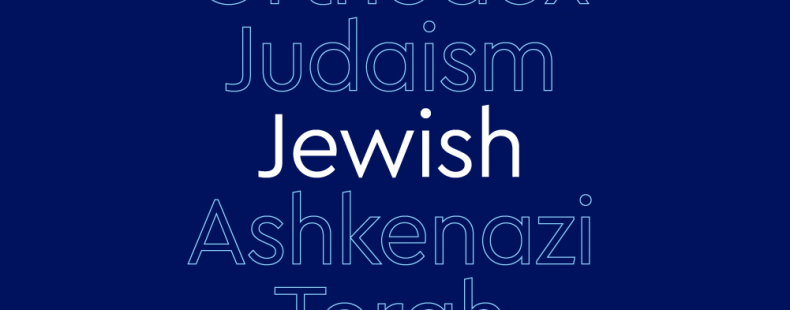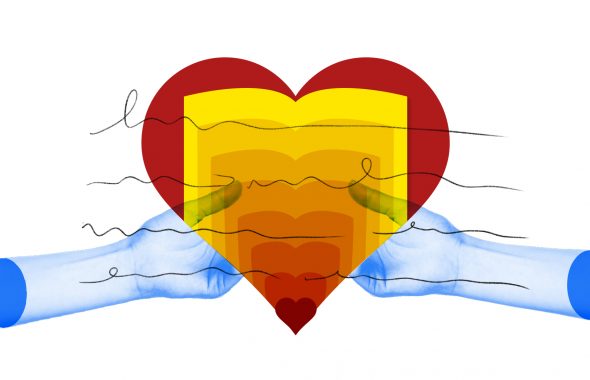by Min Straussman
In 1585, a mining expert named Joachim Gans landed on Roanoke Island in the New World. He is considered the first Jewish person to visit the Americas. Almost 70 years later, in 1654, the first Jewish community was founded in what was then known as New Amsterdam, and what we today call New York City. They came, like so many other early Europeans to the continent, in search of religious freedom. In the time since, the Jewish community in the United States has continued to grow significantly. Today, more Jewish people live in the United States than anywhere else in the world except Israel.
May is Jewish American Heritage Month, which is an opportunity to recognize and celebrate the long history and rich diversity of Jewish life in the United States. Needless to say, things have changed a lot since 23 Sephardi Jews fleeing the Portuguese Inquisition first settled in 1654. We are going to use the opportunity this month to talk about terms like Sephardi Jews, what they mean, and how they help us understand the many different kinds of Jewish American heritages.
The Jewish community is tiny in comparison to the population of the United States. As a result, many people only know about Jewish American life from sources like television shows or movies. This can lead to stereotyping or worse about Jewish people and culture. To help set the record straight, we are going to talk about a variety of aspects of Jewish American life and language many may not be entirely familiar with.
Note: Some sections of this article mention anti-Semitism as well as politics concerning the nation of Israel. While we understand the topics are very sensitive, it’s important to recognize them within the larger context of Jewish identity, life, and culture.
Jewish person or Jew?
For many years, especially following World War II and in reaction to the anti-Semitic use of the word, it was considered offensive to refer to someone as a Jew, using the proper noun form of the term. Instead, it was preferable to use the adjectival form, Jewish. We see this in the phrase Jewish American.
However, in the past decade, there has been a movement to reclaim use of the word Jew by some members of the Jewish community. Essentially, instead of saying “I am a Jewish person,” some choose to say “I am a Jew.” Despite this movement, when using the term it is important to pair it with the indefinite article a or no articles at all, rather than the definite article the. While the difference may seem minor, using the definite article implies a stereotypical, monolithic Jewish figure, which is anti-Semitic. Lastly, the use of Jew as a verb is undeniably offensive.
Additionally, the spelling of anti-Semitic itself is controversial, with some arguing that the hyphen should be dropped. You can read a summary of this debate here.
🔑 Key message about describing the Jewish community
Like in any community, there are a wide variety of preferences and opinions within the Jewish community about how we wish to be described. As a general rule, it is always best to ask someone what their personal preferences are. That said, there are some basic guidelines to consider when using the terms Jewish or Jew.
Jewish religious groups within the US
Like any religion, Judaism has many different denominations or internal religious divisions. In the United States, liberal Jewish traditions such as Reform and Conservative Judaism are especially prevalent. Here are some of the Jewish practices you can find in the US:
- Orthodox Judaism: Orthodox Jews seek to follow the laws and commandments of the Torah (more on that term below) as closely as possible. There are many different sub-denominations of Orthodox Judaism including Haredi, known more widely as “ultra-Orthodox” although this term is not used by members of this community itself, and Hasidic Jews, known for their highly traditionalist interpretations of scripture. Regardless of denomination, most Orthodox Jews wear modest clothing and cover their heads, and the men have long forelocks known as payot.
- Conservative Judaism: Conservative Judaism was essentially founded in the United States. It was created to meet the growing desire among Jewish Americans to move away from the strict rules of Orthodox Judaism and to allow practices like men and women sitting together in synagogue.
- Reform Judaism: Reform Judaism traces its origins back to a German movement that sought to combine Enlightenment values with religious tradition. It is less traditionalist than most other Jewish denominations.
- Reconstructionist Judaism: This offshoot of Conservative Judaism was founded in the United States in the 1960s. It is a very liberal tradition that was one of the first to ordain women as rabbis.
The diversity of Jewish cultural groups
In the United States, there are Jewish people of every race, color, ethnicity, national origin, language group, you name it. Despite common stereotypes, there is no particular way a Jewish American looks or sounds or acts or is named. To put it bluntly, not all Jewish Americans are white Ashkenazim who live in New York City and eat lox and bagels. Like all Americans, they’re an incredible mix of cultures and experiences. We can’t possibly cover all of these experiences here, but we wanted to touch on a few of the different Jewish cultural groups in the United States:
- Ashkenazi: Ashkenazi, plural Ashkenazim, comes from the placename Ashkenaz, a land referenced in the Bible thought to be near Armenia (it’s a point of dispute). Despite the confusion around the historical geography, modern Ashkenazi Jews have German and Eastern European heritage. Most Jews in the United States today identify as Ashkenazi.
- Mizrahi: Mizrahim are descendants of Jewish communities in the Middle East and North Africa, including Iraq and Syria. Unfortunately, Mizrahi Jews have historically faced discrimination and marginalization within the Jewish American community and in general. A recent movement tried to get MENA (Middle East and North Africa) added as an ethnic category to the US Census, in part to improve the visibility of Mizrahi Jews as Jews of Color, but the effort has so far been unsuccessful.
- Sephardi: The word Sephardi comes from the placename Sepharad, a Biblical land thought to have existed on the Iberian peninsula. Sephardi Jews originally come from Spain, Portugal, and North Africa. The Ladino language, a mix of Hebrew and Spanish, is spoken by some within this community.
What is Yiddish?
By the middle of the 18th century, most Jews in the United States were Ashkenazi, of German or Eastern European descent. The language many members of this Jewish community spoke was Yiddish, a mix of German, Hebrew, Polish, and other languages. Yiddish is written using the Hebrew alphabet and is read from right to left. Today, only the Orthodox speak exclusively Yiddish, but many American Ashkenazi Jews still sprinkle their language with Yiddish words and phrases. Some of these terms have filtered into the wider American lexicon and you may recognize them:
- oy veh (iz mir): You may have heard the expression oy veh [ oi vey ], but did you know it’s an abbreviation? The whole expression means “Oh, woe is me!” and it is usually said with a bit of a groan.
- kibitz: If you have a co-worker who won’t stop gossiping even when you’re trying to focus, you’ve come across a kibitzer. The verb, kibitz, means “to chitchat.”
- meshugas: What is this meshugas? If you’re hearing this question, something has gone dreadfully wrong. From the Hebrew for “to go astray,” meshugas means “craziness” or “foolishness.”
- shul: The Jewish house of worship is known alternatively as a synagogue or a temple, but in the United States it’s also sometimes known as a shul, the Yiddish word for “synagogue.” The word shul comes from the Old High German sculoa, meaning “school.”
Talking about Jewish religious life
While Jews of different denominations and cultural backgrounds have different practices, there are some terms that come up across the board.
- kosher: Observant Jews follow certain dietary guidelines known as the laws of kashrut [ kahsh-root ]. Foods that are allowed to be eaten are known as kosher, from the Hebrew for “right, fit.” For example, one of the basic laws of kashrut is that dairy and meat should not be eaten together.
- bar mitzvah / bat mitzvah / b’nai mitvah: When a Jewish boy comes of age, around the age of 13, he has a bar mitzvah, meaning “son of the law” in Hebrew, where he reads the Torah in front of the Jewish community. The female equivalent, practiced in most liberal denominations, is known as a bat mitzvah (bat means “daughter”). The plural of these terms is b’nai mitzvah for a mixed-gender group or b’not mitzvah for a female group.
- Torah: The holy book for the Jewish people is the Torah, or the Five Books of Moses. It is composed of what are known in English as the books of Genesis, Exodus, Leviticus, Numbers, and Deuteronomy.
- Talmud: The Talmud, from the Hebrew for “instruction,” is a collection of Torah commentary and exegesis that is also studied by observant Jews. It is the written record of oral discussion and religious teachings.
What is Zionism?
Zionism is a global, political movement for the creation and support of a Jewish state in Israel. There is a long history of American Jews supporting Zionist movements and causes. However, it is important to note that Zionism is a political movement, not a religious one. That means not all Jews are Zionists and not all Zionists are Jews. For example, an evangelical Christian who supports a Jewish homeland in Israel is a Zionist, even though they are not Jewish.
Today, many Jewish Americans, especially and increasingly younger ones, are critical of Israel. One popular outlet for this criticism is BDS, or Boycott, Divestment, Sanction, a movement that puts economic pressure on Israel to change its policies towards Palestinians.
The question of support for Israel is a highly contentious one for the Jewish American community. That said, we should keep in mind that the Jewish American community is distinct from the Israeli one in many ways. As we have seen, there is a lot more to Jewish American cultural and religious life than Zionism.
Jewish American political and social organizations
There are hundreds of Jewish American organizations that have worked for decades to create political and social change. Some of these groups support Jewish Americans specifically, others work on behalf of marginalized communities regardless of religious denomination. A few examples of prominent Jewish American organizations are:
- Anti-Defamation League (ADL): Founded in 1913, the ADL researches anti-Semitic language and attacks in the United States.
- American Israel Public Affairs Committee (AIPAC): The most prominent pro-Israel lobbying group, AIPAC works to ensure the United States government continues to support a Jewish state in Israel.
- Jewish Voice for Peace (JVP): JVP is an organization that promotes the BDS movement in the United States and is critical of Israel.
- Hebrew Immigrant Aid Society (HIAS): Originally founded in 1881 to support Jewish refugees to the United States, today HIAS helps resettle refugees from around the world in the United States.
- American Jewish World Service (AJWS): The AJWS is a nonprofit that supports human rights and works to end poverty around the world.
Sources and additional resources
This article has drawn on a variety of sources about Jewish American culture. Obviously, we’ve only highlighted some of the key elements here, and we encourage you to keep learning more on your own. We found these sources invaluable, and they’ll provide a great start to your own studies:
- official Jewish American Heritage Month website
- Jewish American Heritage Collection of the American Archive of Public Broadcasting
- Jewish Virtual Library
- American Jewish Historical Society timeline
- American Jewish Archives
If you’re interested in hearing even more from us about the unique history of the Jewish people in the United States, check out our entry on Jewish American Heritage Month. With over 400 years of history in North America, there is a lot to discover about Jewish American life, past and present.
Min Straussman is a freelance writer and educator from Pittsburgh, Pennsylvania. A frequent contributor to Dictionary.com and Thesaurus.com, his work has also appeared in Hey Alma, beestung, and other publications. He lives in Paris.













